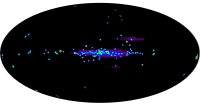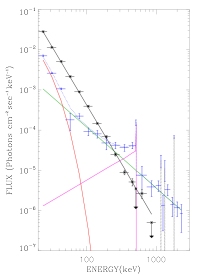INTEGRAL deciphers diffuse signature of cosmic-ray electrons
21 December 2011
Astronomers exploiting six years worth of data from ESA's INTEGRAL mission have pinned down the individual processes contributing to the high-energy Galactic interstellar emission produced by cosmic-ray electrons. Deciphering each of the different physical mechanisms at play at hard X-ray and soft gamma-ray wavelengths represents a crucial step towards an increasingly detailed picture of the population of high-energy particles permeating the Milky Way.
 |
|
The hard X-ray sky as seen with INTEGRAL/SPI. |
Researchers study these particles either directly, by detecting the tracks that arise from collisions with material in the Earth's atmosphere, or indirectly, by tracing the radiation emitted when cosmic rays interact with different components of a galaxy – for example, other particles, photons, magnetic fields. In the Milky Way, these phenomena are among the primary sources of the distinctive 'diffuse' emission that is seen along the Galactic Plane, at both the low energy (radio, microwave) and high energy (hard X-ray, gamma ray) ends of the electromagnetic spectrum.
This 'glow' is due to a combination of many different processes. Extensive observations across many wavelengths, as well as detailed physical modelling, are required to disentangle all contributions and to help solve the puzzle of the charged particles that fill our Galaxy.
"The diffuse emission at hard X-ray and soft gamma-ray wavelengths is an excellent tracer of cosmic-ray electrons and their antiparticles, the positrons, a minor but very significant fraction of the high-energy particle population in the Milky Way," explains Laurent Bouchet from Université de Toulouse and Institut de Recherche en Astrophysique et Planétologie (IRAP) in France. Bouchet and his international team exploited data from ESA's INTEGRAL mission, probing the entire sky at energies between 20 keV and 2.4 MeV. Exploring the diffuse emission in this energy range is one of the main science goals of the INTEGRAL mission, and after almost a decade of operation the mission has finally achieved the unprecedented sensitivity required to push this inquiry to the next level.
The study conducted by Bouchet and his collaborators relies on data collected with the Spectrometer on board INTEGRAL (SPI) over a time span of six years. "Such a long exposure allowed us to isolate, with very high precision, the different physical processes that account for the total emission in the spectral window probed by INTEGRAL," he adds.
The first step in the complex analysis performed by the team consists of a careful scrutiny of the data to remove all point sources, both galactic and extragalactic, that radiate at these wavelengths. In this context, point sources represent a contamination of the diffuse signal produced by cosmic rays. "We have identified a few hundred sources across the entire sky and established that their contribution is dominant at the lowest energies examined in this work, between 20 and 100 keV," notes Bouchet. After point-source removal, the observed diffuse emission was compared with model predictions, in order to break it down into the individual physical processes that contribute to it.
 |
|
Different contributions to the total emission at hard X-ray and soft gamma-ray energies, as measured with INTEGRAL/SPI. Courtesy of L. Bouchet (Univ. Toulouse and IRAP) |
The team made use of a very detailed model of the interstellar radiation field in the inner part of the Galaxy, a crucial ingredient to be taken into account in order to achieve a thorough physical interpretation of the observed emission. "Together with the latest models and improved data analysis techniques, the new INTEGRAL data allowed us to unequivocally identify IC scattering as the principal mechanism producing diffuse emission between 100 and 200 keV, as well as between 600 keV and 2 MeV," adds Strong.
Besides the clear feature of IC scattering, the data also exhibit the well studied signatures of other emission processes arising in this spectral band – the annihilation of positrons with electrons and the radioactive decay of some unstable atomic nuclei. When positrons and electrons collide, two things may happen: they may destroy each other immediately, releasing a pair of photons each with an energy of 511 keV; alternatively, they may create an unstable and short-lived two-particle system called positronium, which soon decays into two or more photons, producing a distinctive continuum emission spectrum up to 511 keV. At energies above 1 MeV, the data also exhibit characteristic decay features of two unstable isotopes of aluminium (26Al) and iron (60Fe). This indicates the presence of these radioactive nuclei - the products of recent nucleosynthesis in supernova explosions - throughout the diffuse interstellar medium of the Milky Way.
"In addition to these mechanisms, the data require a further component to be taken into account at low energies, below 50 keV," notes Bouchet. "This is most likely due to the superposition of many unresolved faint sources, as pointed out by previous studies based on data from the IBIS imager on board INTEGRAL," he adds. Stars with very hot coronae and cataclysmic variable stars are the main objects contributing to this unresolved emission.
The study of Bouchet and collaborators enabled models of cosmic ray propagation to be tested in this portion of the electromagnetic spectrum in greater detail than previously possible. "The data demonstrate that our current understanding of the properties of cosmic-ray electrons in the Milky Way is qualitatively correct," notes Strong. As INTEGRAL keeps scanning the high-energy sky, even longer exposures will be available in the future. "With more data and improved analysis methodology, we plan to explore quantitatively the distribution of cosmic-ray electrons across the Galaxy, narrowing down important parameters such as the size of the Galactic region within which the particles are confined," he adds.
Ultimately, it is essential to verify that the data fit well within the physical scenario suggested by other observations. In particular, there is a consensus on the general picture provided by both INTEGRAL and the Large Area Telescope (LAT) on board NASA's Fermi Gamma-ray Space Telescope. Sensitive to gamma rays between 20 MeV and 300 GeV, Fermi-LAT observes the sky at higher energies than INTEGRAL, and the agreement reached by these two complementary missions is very encouraging.
"This long-awaited result showcases INTEGRAL's uniqueness in probing such a crucial spectral window," comments Chris Winkler, INTEGRAL Project Scientist at ESA. "The large amount of data accumulated by INTEGRAL is now revealing the mission's full potential for exciting results and discoveries."
Notes for editors
The study presented here is based on observations performed with the Spectrometer on board INTEGRAL (SPI) between 22 February 2003 and 2 January 2009. The data probe the entire sky at energies between 20 keV and 2.4 MeV.
The data were compared to model predictions obtained with GALPROP, a publicly available code for calculating the propagation of cosmic-ray nuclei, antiprotons, electrons and positrons. The code also computes diffuse gamma-ray and synchrotron emission resulting from the cosmic rays. The first version of GALPROP was developed in the mid-1990s by Andrew W. Strong (MPE, Germany) and Igor V. Moskalenko (Stanford University, USA), both co-authors of the paper presented here. The code is currently maintained by a small team of researchers. In particular, GALPROP includes the most advanced model presently available of the interstellar radiation in the inner Galaxy, which has been developed by Troy A. Porter (Stanford University, USA), who is also a co-author of the paper presented here.
INTEGRAL is an ESA project with instruments and science data centre funded by ESA Member States (especially the Principal Investigator countries: Denmark, France, Germany, Italy, Spain, Switzerland) and Poland, and with the participation of Russia and the USA.
Related publications
L. Bouchet, et al., "Diffuse Emission Measurement with the SPectrometer on Integral as an Indirect Probe of Cosmic-ray Electrons and Positrons", 2011, The Astrophysical Journal, 739, 29
Contacts
Laurent Bouchet
Université de Toulouse
and Institut de Recherche en Astrophysique et Planétologie (IRAP)
Toulouse, France
Email: bouchet cesr.fr
cesr.fr
Phone: +33-561-55-86-03
Andrew W. Strong
Max-Planck Institut für Extraterrestrische Physik (MPE)
Garching bei München, Germany
Email: aws mpe.mpg.de
mpe.mpg.de
Phone: +49-89-30000-3575
Chris Winkler, INTEGRAL Project Scientist
Research and Scientific Support Department
Directorate of Science and Robotic Exploration
ESA, The Netherlands
Email: cwinkler rssd.esa.int
rssd.esa.int
Phone: +31-71-565-3591

